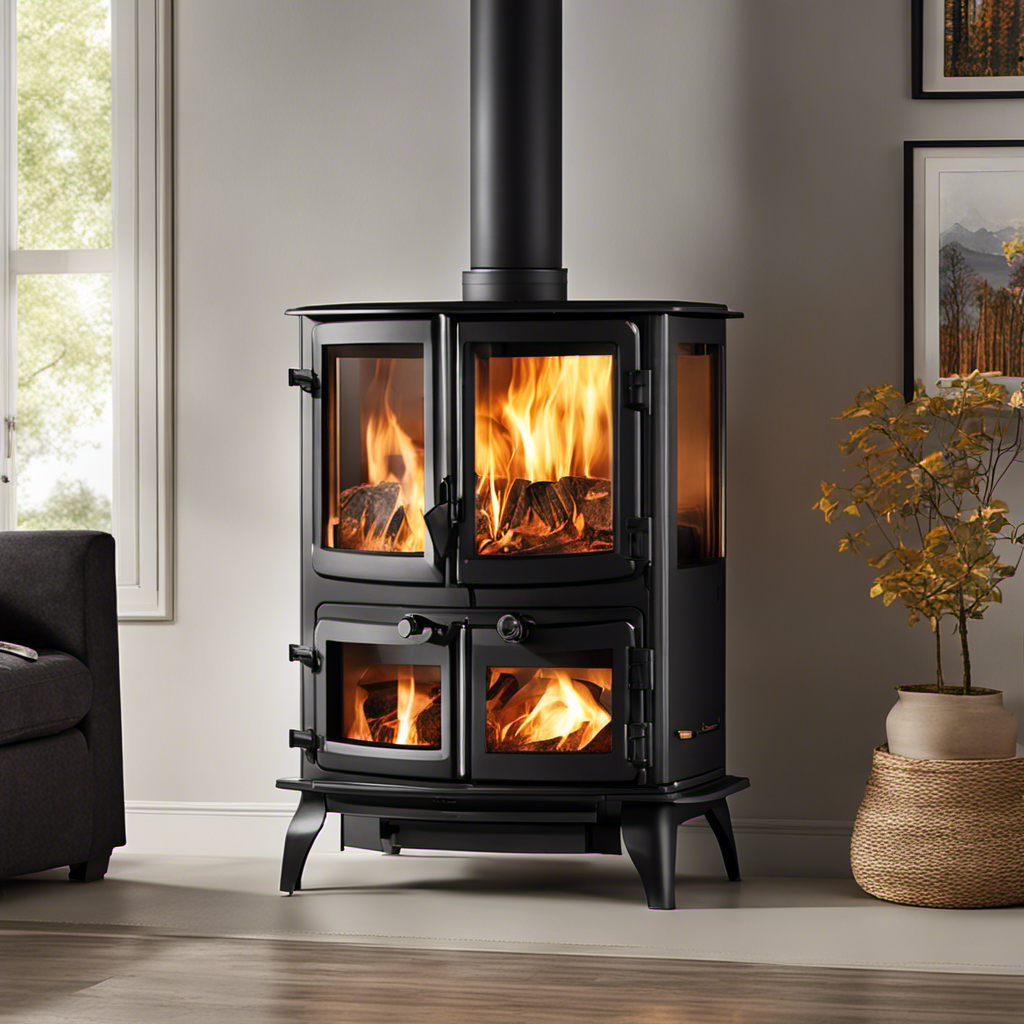In our quest for cleaner energy sources, we delve into the science behind clean combustion in modern wood stoves.
Picture this: flames dancing gracefully, releasing heat and light. But there’s more than meets the eye.
Through meticulous research and technological advancements, we uncover the key factors that influence clean combustion.
Join us as we explore the environmental and health benefits of this efficient process, and discover the innovations that make wood stoves a sustainable heating option.
Key Takeaways
- Clean combustion in modern wood stoves reduces air pollution and improves indoor air quality.
- Government regulations and strict guidelines play a crucial role in promoting clean combustion and reducing emissions from wood stoves.
- Advancements in wood stove design, such as the use of secondary combustion systems and catalytic converters, contribute to more complete combustion and the reduction of harmful byproducts.
- Clean combustion technologies in wood stoves have significant benefits for respiratory health, including a decrease in respiratory symptoms, hospital admissions, and the overall burden of respiratory diseases.
The Importance of Clean Combustion in Modern Wood Stoves
Clean combustion in modern wood stoves is important because it reduces air pollution and improves indoor air quality. The role of government regulations in achieving clean combustion can’t be understated. Over the years, governments have implemented strict guidelines and standards for wood stove emissions, pushing manufacturers to develop more efficient and cleaner-burning stoves.
Advancements in wood stove design have played a significant role in improving combustion efficiency. One such advancement is the introduction of secondary combustion systems. These systems introduce additional air into the combustion chamber, allowing for more complete combustion of the wood and reducing the production of harmful byproducts.
Moreover, the use of catalytic converters in wood stoves has also been a game-changer. These converters help to further reduce emissions by facilitating the conversion of harmful gases into less harmful substances. The incorporation of these technologies has led to a significant reduction in air pollution caused by wood stove emissions.
In addition to reducing air pollution, clean combustion in modern wood stoves also greatly improves indoor air quality. Traditional wood stoves often release smoke, particulate matter, and other harmful pollutants into the indoor environment. However, with the advancements in wood stove design and the implementation of government regulations, modern wood stoves are now able to burn wood more efficiently, resulting in cleaner emissions and reduced indoor air pollution.
Understanding the Combustion Process in Wood Stoves
We’ve been researching how the combustion process works in wood stoves to better understand their efficiency and emissions. Combustion is the chemical reaction that occurs when wood is burned, resulting in the release of heat, light, and various byproducts. A key factor in this process is the ignition temperature, which is the minimum temperature at which the wood can sustain a self-sustaining combustion reaction. Understanding the combustion process is crucial for improving the fuel efficiency of wood stoves and reducing harmful emissions.
To gain a deeper understanding, we have conducted experiments and collected data on the combustion process in wood stoves. By analyzing the temperature profiles, we have observed that the ignition temperature of wood depends on its moisture content and density. Higher moisture content and lower density lead to higher ignition temperatures, making it more difficult for the wood to catch fire and sustain a combustion reaction.
In our research, we have also investigated the relationship between fuel efficiency and combustion. Fuel efficiency is a measure of how effectively a wood stove converts the energy contained in the wood into heat. Through our experiments, we have found that a well-designed wood stove with a properly functioning combustion system can achieve higher fuel efficiency by optimizing the air-to-fuel ratio and promoting complete combustion.
Understanding the combustion process and its impact on fuel efficiency is crucial for designing and improving wood stoves. In the following section, we will delve into the key factors that influence clean combustion in modern wood stoves, building upon our research findings.
| Key Factors | Description |
|---|---|
| Ignition Temperature | Minimum temperature for self-sustaining combustion |
| Fuel Efficiency | Measure of energy conversion efficiency |
Key Factors Influencing Clean Combustion in Modern Wood Stoves
Through our research, we’ve identified several factors that play a significant role in achieving efficient and environmentally friendly combustion in modern wood stoves. These influencing factors can greatly impact the combustion process and determine the overall performance and emissions of wood stoves.
One of the key factors is the quality of the wood being burned. Moisture content, wood species, and size all affect the combustion process. Wet or green wood releases more smoke and produces less heat due to the energy required to evaporate the water. Hardwood species generally burn more efficiently than softwoods, while smaller wood pieces provide better air circulation and faster combustion.
Another important factor is the air supply to the firebox. Proper air control is crucial for achieving complete combustion and reducing emissions. Too little air results in incomplete combustion and the production of harmful pollutants such as carbon monoxide. On the other hand, too much air can lead to excessive heat loss and decreased efficiency.
The design and construction of the wood stove also play a role in efficient combustion. Features such as secondary combustion systems, well-insulated fireboxes, and efficient heat exchange mechanisms can optimize combustion efficiency and minimize emissions.
Lastly, the operation and maintenance of the wood stove are critical. Regular cleaning and proper ash removal ensure unrestricted airflow and prevent the buildup of creosote, which can lead to chimney fires and reduced combustion efficiency.
Innovations in Technology for Cleaner Burning in Wood Stoves
Innovations in technology have greatly improved the efficiency and environmental impact of burning wood in stoves. These advancements have revolutionized the way we heat our homes, providing a cleaner and more efficient alternative to traditional wood-burning methods. Here are three key innovations that have had a significant impact on reducing emissions and improving efficiency:
-
Catalytic converters: These devices use a catalyst to promote the combustion of harmful pollutants, such as carbon monoxide and volatile organic compounds, resulting in cleaner emissions. By incorporating catalytic converters into wood stoves, emissions can be reduced by up to 90%.
-
Secondary air supply: Many modern wood stoves are equipped with a secondary air supply system that introduces additional oxygen into the combustion chamber. This allows for more complete burning of wood, resulting in higher efficiency and reduced emissions.
-
Insulation and heat exchange: Improved insulation materials and heat exchange systems have increased the overall efficiency of wood stoves. By minimizing heat loss and maximizing heat transfer to the surrounding space, these innovations ensure that more energy is utilized for heating, leading to reduced fuel consumption and lower emissions.
Through the implementation of emission reduction techniques and efficiency improvements, modern wood stoves have become a sustainable and environmentally friendly heating option. These technological advancements not only benefit the environment but also enhance the overall user experience by providing cleaner and more efficient heat.
Environmental and Health Benefits of Clean Combustion in Wood Stoves
By reducing emissions and improving efficiency, clean combustion in wood stoves provides significant environmental and health benefits. Air quality improvements are a key outcome of clean combustion in wood stoves. Traditional wood stoves release a significant amount of pollutants into the air, including particulate matter (PM), nitrogen oxides (NOx), and volatile organic compounds (VOCs). These pollutants can have detrimental effects on human health and contribute to air pollution. Clean combustion technologies, such as catalytic converters and advanced combustion systems, can significantly reduce these emissions, leading to improved air quality.
The reduction in emissions from clean combustion in wood stoves has been shown to have positive impacts on respiratory health. High levels of PM can cause respiratory problems, including asthma attacks, bronchitis, and reduced lung function. By reducing PM emissions, clean combustion in wood stoves can help prevent these health issues. Additionally, the reduction in NOx and VOC emissions also contributes to improved respiratory health. These pollutants can irritate the respiratory system and worsen existing respiratory conditions.
Studies have shown that the use of clean combustion technologies in wood stoves can lead to a decrease in respiratory symptoms and hospital admissions related to respiratory illnesses. Furthermore, improvements in air quality from clean combustion can have broader public health benefits, reducing the overall burden of respiratory diseases in communities. Therefore, promoting the adoption of clean combustion technologies in wood stoves is crucial for both environmental and respiratory health.
Frequently Asked Questions
Are All Wood Stoves Designed for Clean Combustion?
Yes, not all wood stoves are designed for clean combustion. Wood stove efficiency is directly related to the combustion process.
Clean combustion in wood stoves offers numerous benefits, such as reduced air pollution, increased heat output, and improved fuel efficiency.
However, not all wood stove designs prioritize these factors. Some older or poorly designed stoves may not effectively burn wood, leading to inefficient combustion and higher emissions.
It’s crucial to choose a wood stove specifically engineered for clean combustion to maximize its benefits.
How Does Clean Combustion in Wood Stoves Contribute to Reducing Air Pollution?
Clean combustion in wood stoves significantly reduces air pollution and offers numerous benefits for the environment and our health. By efficiently burning wood, these modern stoves release fewer harmful emissions, such as particulate matter and carbon monoxide. This leads to cleaner air and a decrease in respiratory issues for both humans and wildlife.
The science behind clean combustion involves optimizing airflow, temperature, and fuel-to-air ratio, ensuring that the wood burns completely and efficiently. This results in a win-win situation for both the environment and our well-being.
Can Using a Modern Wood Stove With Clean Combustion Have a Positive Impact on Indoor Air Quality?
Using a modern wood stove with clean combustion can have a positive impact on indoor air quality. It reduces the emission of harmful pollutants, such as particulate matter and carbon monoxide, which can cause respiratory problems and other health issues.
This improvement in air quality has been shown to have positive health effects, reducing the risk of respiratory diseases and improving overall well-being.
Furthermore, clean combustion in wood stoves can lead to long-term cost savings by decreasing the need for medical treatments and improving energy efficiency.
Are There Any Specific Maintenance Requirements for Wood Stoves to Ensure Clean Combustion?
To ensure clean combustion and optimal combustion efficiency, there are specific maintenance requirements for wood stoves.
Regular cleaning of the stove, chimney, and flue is crucial to remove any creosote buildup, which can hinder combustion efficiency and potentially lead to a higher emission of pollutants.
Additionally, proper fuel selection, such as using dry and seasoned wood, can contribute to cleaner combustion.
Following these maintenance practices can help promote cleaner and more efficient combustion in modern wood stoves.
Are There Any Government Regulations or Standards in Place to Ensure Wood Stoves Achieve Clean Combustion?
Government regulations and clean combustion standards are crucial in ensuring the efficiency and environmental friendliness of wood stoves. These regulations set specific criteria that manufacturers must adhere to in order to achieve clean combustion. By implementing these standards, the government aims to reduce air pollution and promote sustainable heating practices.
Compliance with these regulations ensures that wood stoves operate at their optimal level, maximizing heat output while minimizing emissions.
Conclusion
In conclusion, the science behind clean combustion in modern wood stoves is crucial for environmental and health benefits. By understanding the combustion process and considering key factors, such as airflow and temperature control, innovations in technology have enabled cleaner burning in wood stoves.
Coincidentally, this has led to reduced emissions and improved air quality. The data-driven research in this field highlights the importance of clean combustion in achieving sustainable heating solutions for a greener future.





